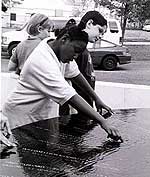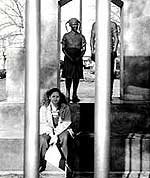By Brandt Williams
Minnesota Public Radio
March 26, 2002
|
| RealAudio |
Twenty students from the Southside Family School in Minneapolis leave Tuesday for an ambitious field trip, to learn more about the civil rights movement. The elementary school students and teachers take a 10-day bus tour to the southern United States - to cities where some of the most significant events in the civil rights movement took place. The students won't just snap photos and visit museums. They will gather information directly from people who participated in the movement.
| |
|
|
|
||
Every February, school children across the country are given lessons on black history. They focus on famous black scholars, athletes, artists and activists like the icons of the civil rights movement - Dr. Martin Luther King, Jr. and Rosa Parks.
But at the Southside Family School, black history is part of the year-round curriculum.
Teacher Susie Oppenheim leads her class in a discussion about the lynching of three black men in Duluth in 1920. Student Tressi Stigler tells the class the lynching was preceded by a period when many white war veterans returned home to find that blacks occupied their jobs.
The companies hired black workers because they would work for lower wages than white workers. Oppenheim tells the students that some large companies in southern cities did the same thing. She says companies benefited from the animosity between black and white workers.
"Did the company encourage it? They certainly did," said Oppenheim. "Because if all of us in this room got together and decided to make a change, we have a much better chance than if just one of us decided to do it - right?"
Since January, the students have prepared for their trip by studying about the cities they will visit and the people they will meet.
On their 3,000 mile trek, they will visit cities like Birmingham, Ala., where marching children were knocked over by fire hoses and attacked by police dogs.
| |
|
|
|
||
They will also meet people who participated in these demonstrations when they were children.
Some of the students, like Searcie Cassidine, were on the school's last civil rights tour three years ago. She says it's a way to learn things about the civil rights movement that most people her age don't know about.
"I just want to hear stories about it - because that's the most interesting to learn - from the people who were actually in it, and for them to tell first-hand what it was like for them," Cassidine says.
Teacher Susie Oppenheim is one of the architects of the Southside Family School's curriculum. She has taken students on extensive field trips for nearly 20 years.
Until the first civil rights tour in 1993, the school took students to areas of Minnesota like the Iron Range.
She says the trips are a great learning experience for all students, but especially so for students who struggle in traditional classroom settings.
"If you take it out and make it experiential, then suddenly those kids who haven't responded well in the classroom are responding much better - it's hitting them at a new level," says Oppenheim.
Besides a focus on basic skills, the Southside Family school's curriculum focuses on activities that attempt to teach students to respect all people - regardless of race, sex, class and sexual orientation.
When they return, the students will present a slideshow documentary of their trip to schools, churches, businesses and civic organizations.
More from MPRMore Information


